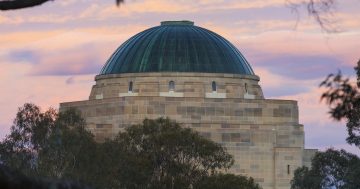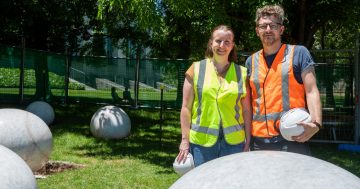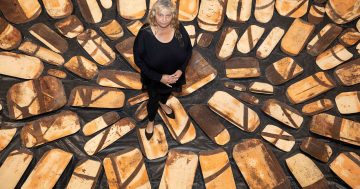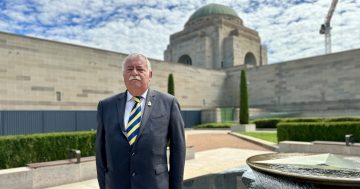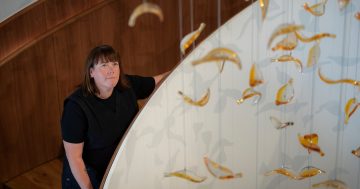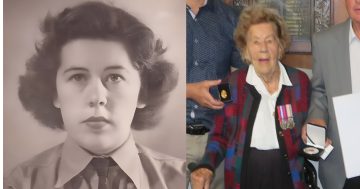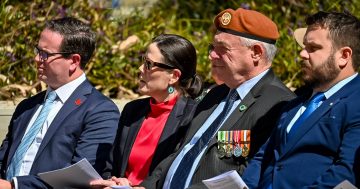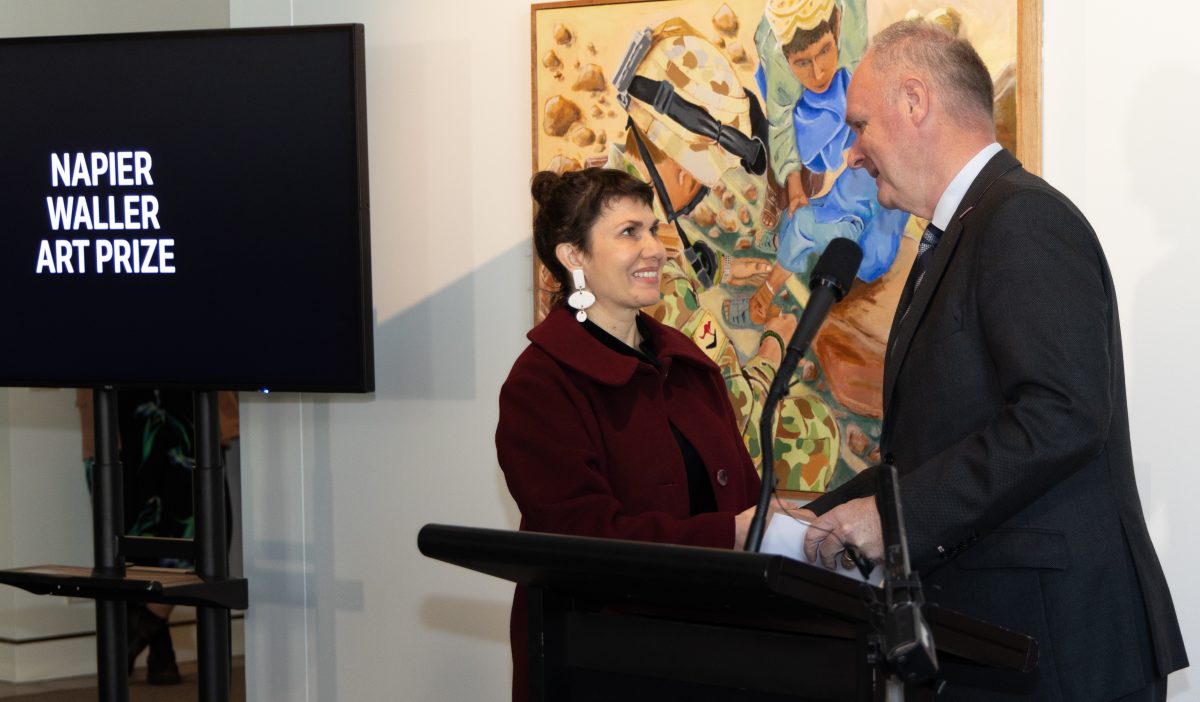
Winner of the 2024 Napier Art Prize, former member of the ADF and now artist, Kat Rae is congratulated by the Director of the Australian War Memorial, Matt Anderson. Photo: Australian War Memorial.
The tall, precarious pile of papers, folders, envelopes and army-issue bags measures 157cm, the height of its creator Kat Rae. It tips the scales at 95kg, the weight of Kat’s husband Andrew, who committed suicide in 2017.
When former army veteran and now artist Kat created the structure, she didn’t know it would match her height. Nor did she know it would weigh the same as her late husband.
What she did know was that she needed to tell a story about the other veterans who struggled to deal with life post-deployment and about those who didn’t come home – a story with which she knew so many other Defence families could identify.
Kat’s work Deathmin is a tower of grief made up of stacks of Australian Defence Force, Department of Defence, Department of Veterans’ Affairs and Royal Commission into Veteran Suicide documents which swamped her and her husband before and after he died.
“There is something very visceral about standing eye to eye with a pile of paperwork a veteran has to submit only to not get the support he needs,” she said.
Deathmin is a work of art, but it’s as much a tribute and statement on how grieving service families are left to deal with tragedy.
In what Kat described as a “brave” move, Deathmin was named winner of the 2024 Napier Waller Art Prize, an award open to current and former Australian Defence Force personnel to use art to share their experiences of life in the military.
“Deathmin is a counter-monument to the strong, upright imagery often conveyed in the Australian War Memorial,” Kat said. “At my height and Andrew’s weight, Deathmin embodies the burden placed on veterans and their families. It asks bureaucratic institutions to care for the people they say they will.”
She said after her husband died in 2017, she “inherited a stack of post-death admin”.
“This ‘deathmin’ contains thousands of pages in which Andrew requests support for his broken body. Eventually, DVA [Department of Veterans’ Affairs] paid $7 fortnightly, later reduced to $5. Three months before Andrew died, payments ceased,” she said.
Kate, who served for 20 years in the Australian Army including multiple deployments to the Middle East, had had enough. Their daughter, only two when her father died, deserved better.
“The paperwork about Andrew just kept accumulating,” Kat said. “I had been stashing it in my daughter’s wardrobe, but there was so much of it. When you get told you’ve fallen through the cracks, you realise it’s not just you hurting, but there are other people as well. That’s what put the fire in my belly, I guess.
“I stacked it all up and realised it was my height. Andrew was a big man, and it weighed just as much as him.
“It made me realise we don’t have a monument that shows the real complexity of war, I wanted this to show the layers of issues and complexities – and that everyone’s story is different.
“I’ve been blown away by how many other vets have told me that this is their story too.”
Kat joined the Australian Army at 18, studying at Duntroon in Canberra, before being deployed overseas. She continued serving after her husband died but her heart wasn’t in it.
“It’s like Annabel Crabb says, the choice you have is to work like you don’t have a child or parent like you don’t have a job,” she said. “I was burnt out, so I decided to leave and go back to what I loved, art.”
She said Deathmin took about a year to create, although the idea had been in her mind for some time.
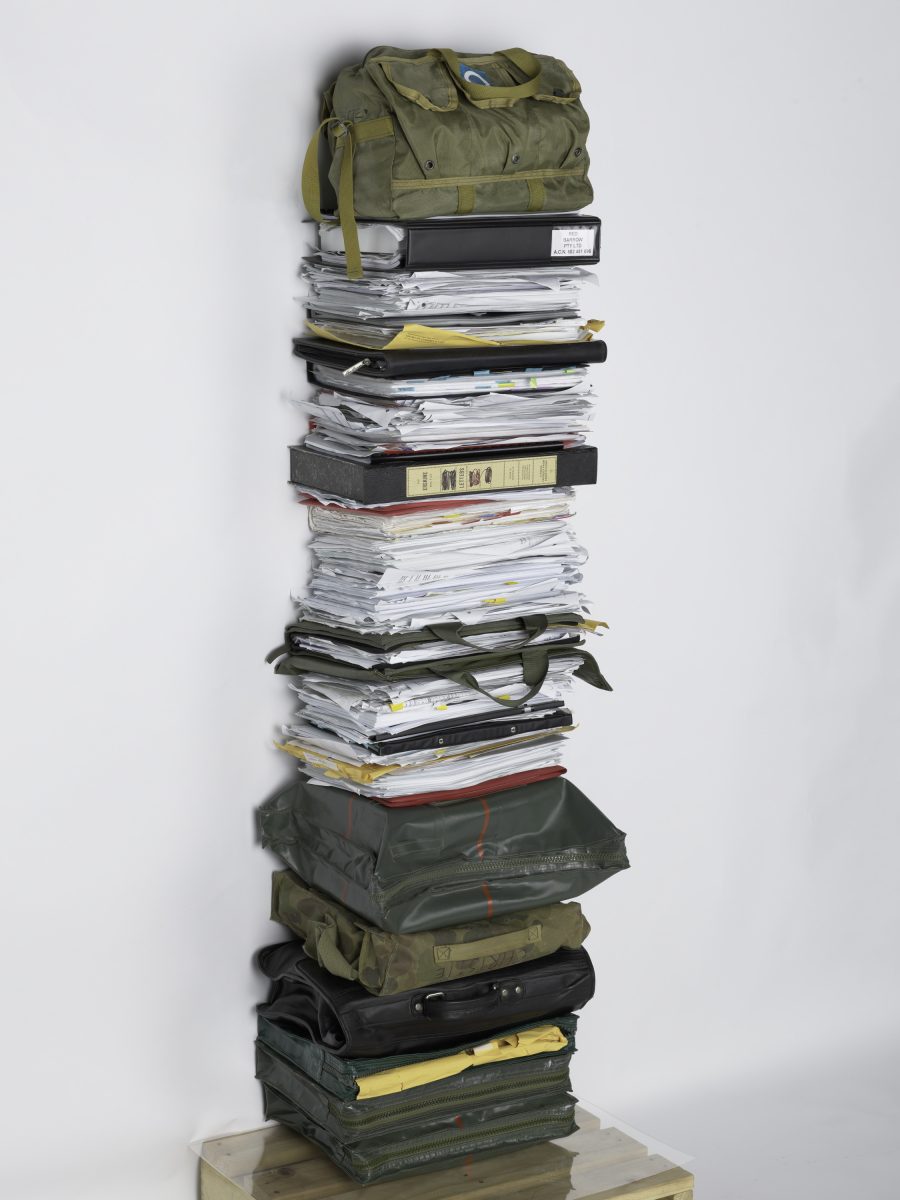
Winner of the 2024 Napier Prize, Deathmin, by artist and former ADF member Kat Rae, a piece in memory of her husband Andrew. Photo: Australian War Memorial.
Kat said she felt proud to receive the award, but also wanted to congratulate the other artists.
The judges described her work as: “… powerful, contemporary and layered with multiple codes: the artist presents us with a stack of the paperwork generated before and after her husband Andrew’s death. At her height and his weight, Deathmin embodies the challenges attested to at the Royal Commission into Defence and Veteran Suicide. This is a vital contribution to public discourse at a time when the nation is grappling with the urgent need to do better; that no one who serves this nation experiences what Andrew and Kathryn went through.”
A selection of the 2024 Napier Prize entries are on display at Australian Parliament House until 13 October. Free exhibition, open daily.












